This post may contain affiliate links. Please read our disclosure policy.
This creamy buckwheat risotto is prepared with buckwheat groats and caramelized mushrooms. Infused with miso for deep umami flavors, nutritional yeast for cheesiness, and plenty of garlic, it’s savory, creamy, and so hearty!

I discovered buckwheat groats a few years ago and instantly fell in love with their unique nuttiness and texture. After making my cashew buckwheat curry and buckwheat chili, I realized that these little groats would make an amazing substitute for rice in a risotto.
Fast forward a few tests to achieve the right texture and creaminess, I came up with a risotto that is not just savory but irresistibly creamy and hearty. The groats add an interesting texture – they are larger and have a slightly firmer bite compared to rice!
The result is a risotto that is wonderfully creamy and rustic and makes the perfect dish to cozy up!
⭐️ Why You Will Love It
A twist on regular rice risotto.
It’s time to put your usual white rice recipe on the shelf and say hello to buckwheat! This plant (it’s not a grain!) is nuttier and earthier than rice and has a slightly chewier texture. It also packs more protein and fiber compared to rice. Win-win!
Made with simple, wholesome ingredients.
If you are a regular reader of Full of Plants, you know that all the recipes here are entirely plant-based. This risotto is no exception to the rule. Even better, it doesn’t contain any cream or milk – meaning you won’t need coconut cream or cashew cream.
The secret to the creaminess lies in the natural starches contained in the buckwheat. On top of that, I mix in miso and vegan butter after cooking the groats, adding a rich buttery goodness that will make you go for seconds!
📘 What Is Buckwheat?
Despite its name, buckwheat doesn’t contain any wheat and is gluten-free! It’s not even a cereal, but a plant that first appeared in South China. Buckwheat is cultivated mainly for its groats, which can be cooked as porridge or milled to make buckwheat flour.
🌾 Ingredient Notes

Buckwheat groats
Buckwheat groats can be found either raw or toasted. Raw groats have a light beige color and a subtle flavor, while toasted groats (also called kasha) have a deeper, nuttier flavor. In this recipe, I use raw buckwheat groats for the simple reason that they have a milder taste and fit the concept of risotto better.
Where to buy: You can buy buckwheat groats in most well-stocked supermarkets and organic food stores or get buckwheat groats online.
Looking for more buckwheat recipes? Check out my homemade buckwheat flakes or these savory buckwheat crêpes!
Mushrooms
You will need two FULL cups of sliced mushrooms plus another cup if you plan on making the topping. I know it sounds like a lot, but trust me, they add a ton of earthiness and texture! After all, who wants a mushroom risotto where the mushrooms are hard to spot?
Use different varieties! In this recipe, I went with a combination of cremini mushrooms and fresh shiitakes, but feel free to use your favorite mushrooms or a mix of different varieties. Chanterelles or portobello are great options.
White wine
I use white wine to deglaze the pan after cooking the mushrooms. This enhances the flavor and brings just enough acidity. Don’t worry about the alcohol content – it will evaporate during the cooking process.
Note: There is no need to open your best bottle of white wine here. Any white wine will work!
Make it alcohol-free: If you cannot have alcohol, replace it with 1 tablespoon of white vinegar and 1/2 cup of water.
Vegetable broth
To add extra flavor, the groats in vegetable broth instead of water.
Note: Since this recipe features white miso, which already adds a good amount of saltiness, ensure you are using low-sodium vegetable broth. If you only have regular vegetable broth on hand, dilute it with 1/3 of water – otherwise, your risotto might be too salty. It’s always wise to slightly underseason and add more salt after tasting. Better safe than sorry!
Aromatics
Like traditional risotto, I start by sautéeing some aromatics like garlic and shallots. You can replace the two shallots with one medium onion.
Nutritional yeast
Instead of relying on store-bought vegan parmesan or cheese, which can be hard to find/expensive/unhealthy, I rely on something much simpler: nutritional yeast! It does a great job of adding a subtle cheesiness to the risotto.
Vegan butter
Stirred in toward the end of cooking, vegan butter adds a rich and creamy mouthfeel, creating a restaurant-quality finish!
Miso
Miso is a key ingredient of this recipe! It brings saltiness and plenty of umami. For those unfamiliar with miso, it’s a Japanese condiment made from fermented soybeans.
Note: I used my homemade chickpea miso here, but any white miso (shiro miso) will work. Just remember that not all miso are equal. Some are saltier, some sweeter, so you may have to adjust slightly the saltiness after cooking.
Herbs
Finally, a sprinkle of freshly chopped herbs, such as parsley or cilantro, adds a touch of freshness and a pop of color!
🥣 How to Make It
- Sauté the aromatics. Heat the butter in a deep, non-stick skillet over medium heat. Once hot, add the minced shallot and garlic, and sauté for 2-3 minutes.
- Cook the mushrooms. Add the sliced mushrooms and sauté for 3 more minutes or until the mushrooms are cooked. Next, add the buckwheat groats and sauté for another 2 minutes.
- Pour in the wine. Deglaze the skillet with the white wine and let simmer for 2-3 minutes to allow the alcohol to evaporate.
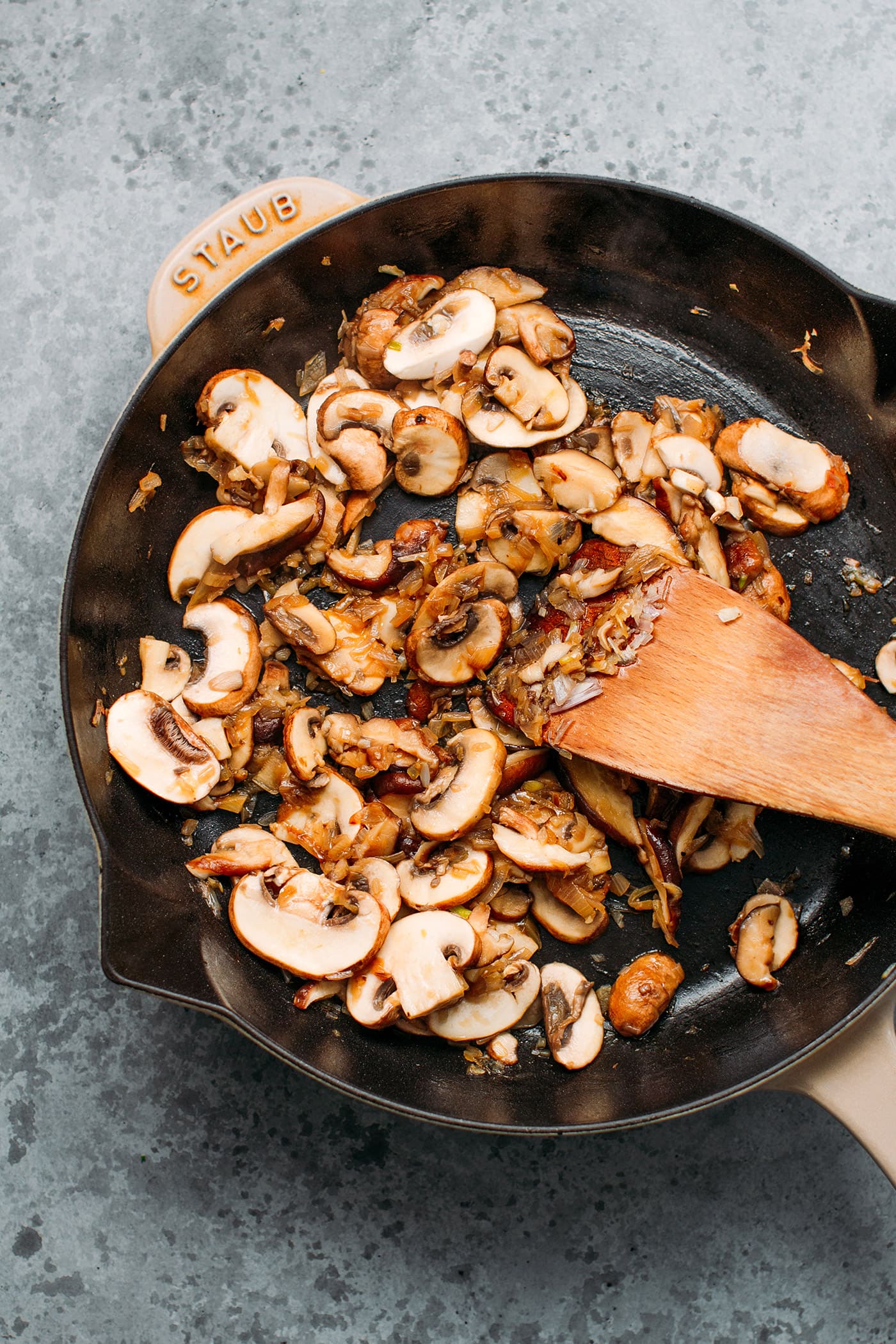
- Let simmer. Pour in the vegetable broth and simmer over low-medium heat, uncovered for about 35 minutes, or until the buckwheat groats are tender. Keep an eye on it and stir regularly. Add more water/vegetable broth if needed, you want the buckwheat groats to have a creamy consistency.
Note: I recommend cooking the groats for about 30 minutes if you want an al dente texture or up to 40 minutes for a very tender bite.
- Season. Once the buckwheat is tender, stir in the nutritional yeast, white miso, vegan butter, and ground black pepper, and cook for one more minute. Taste and adjust the saltiness if needed.
- Serve! Finally, garnish with chopped fresh parsley or cilantro and sautéed mushrooms (optional)!
Extra Sautéed Mushrooms
Although the risotto itself already contains plenty of mushrooms, I like to sauté extra mushrooms on the side to use them later as a finishing touch. To do so:
1. Sauté the mushrooms. While the risotto is cooking, heat a tablespoon of oil in another non-stick skillet over medium heat. Add the sliced mushrooms and cook for 3-5 minutes or until they are slightly golden brown.
2. Season them. Pour in the soy sauce, season with ground black pepper, and toss to coat. Cook for one more minute and set aside.
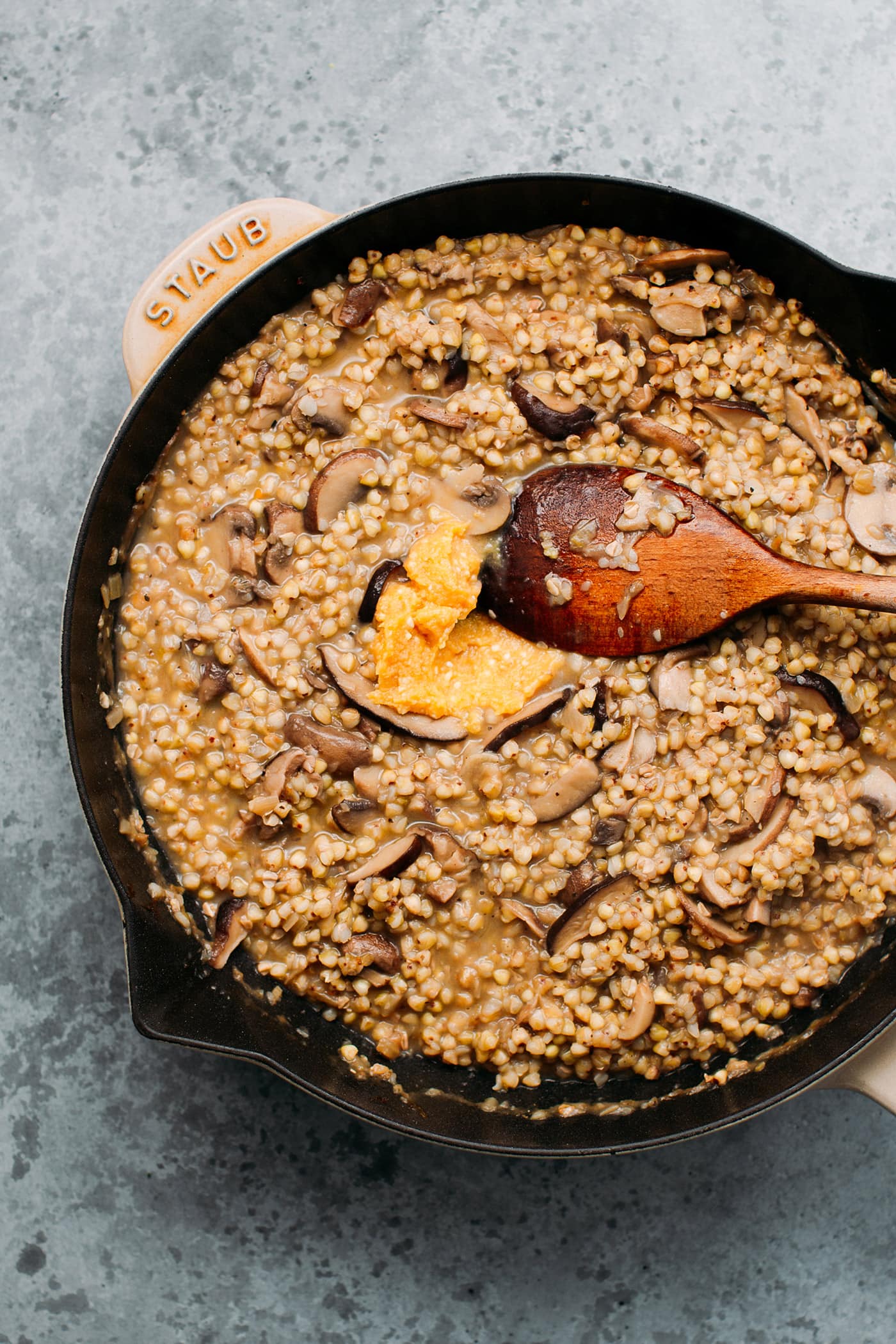
📔 Tips
Use a low-sodium vegetable broth.
As I wrote in the ingredient notes, the miso, which is added toward the end of cooking, adds a lot of saltiness, so it’s essential that you use a low-sodium vegetable broth. Otherwise, your risotto will be too salty.
No low-sodium vegetable broth: Dilute regular broth with 1/3 of water.
Sear the mushrooms.
For extra earthiness, turn the heat up while cooking the mushrooms and sauté them until they are almost charred on the edges. This extra step will slightly caramelize them and add even more flavor!
Monitor the level of liquid.
I suggest staying close to the pan while cooking the groats and adding more vegetable broth if needed. This will prevent the groats from sticking to the bottom and burning.
🔥 Variations
- Stir in vegan cheese: Love super cheesy risotto? Try adding your favorite vegan cheese toward the end of cooking and cook for 1-2 extra minutes. Alternatively, you can simply dice vegan cheese, such as vegan blue cheese or camembert, and use them as a topping.
- Add dried herbs: Season your risotto with dried oregano or thyme for herbaceous notes.
- Top with pine nuts: Toast pine nuts in a skillet for 1-2 minutes or until just golden brown before sprinkling them on top of the risotto for another layer of texture and a touch of nuttiness!
🥖 What to Serve It With
This risotto is delicious paired with:
- Your protein of choice: Vegan marry me chicken, sautéed tofu, seitan, meatballs, meatloaf, or even BBQ pulled mushrooms!
- Veggies: Serve it alongside sautéed vegetables such as green beans, kale, or broccoli.
- Bread: For a heartier meal, you can serve the risotto with air fryer garlic bread, rustic baguette, or even croutons!
❄️ Storing and Reheating
- To store: You can store the risotto in the refrigerator for up to 3 days.
- To freeze: Allow the risotto to cool completely before transferring it to a freezer-safe container. Freezer for up to 2 months. Thaw overnight in the refrigerator before reheating.
- To reheat: Reheat in a non-stick skillet over low-medium heat for 5-8 minutes, stirring regularly. If the risotto has thickened too much, add a few tablespoons of water and a pinch of salt to thin it out.
💬 FAQ
Buckwheat is grain-free, but since this recipe uses miso, which contains rice, it’s not entirely grain-free.
Yes, you can replace the white wine with 1/2 cup of water and 1 tablespoon of white vinegar.
You most probably overcooked the buckwheat groats. I recommend tasting them toward the end of cooking and adjusting the cooking time depending on how firm you want them.
Although I haven’t tried it, I think this recipe will work in an Instant Pot as well using the Sauté function.
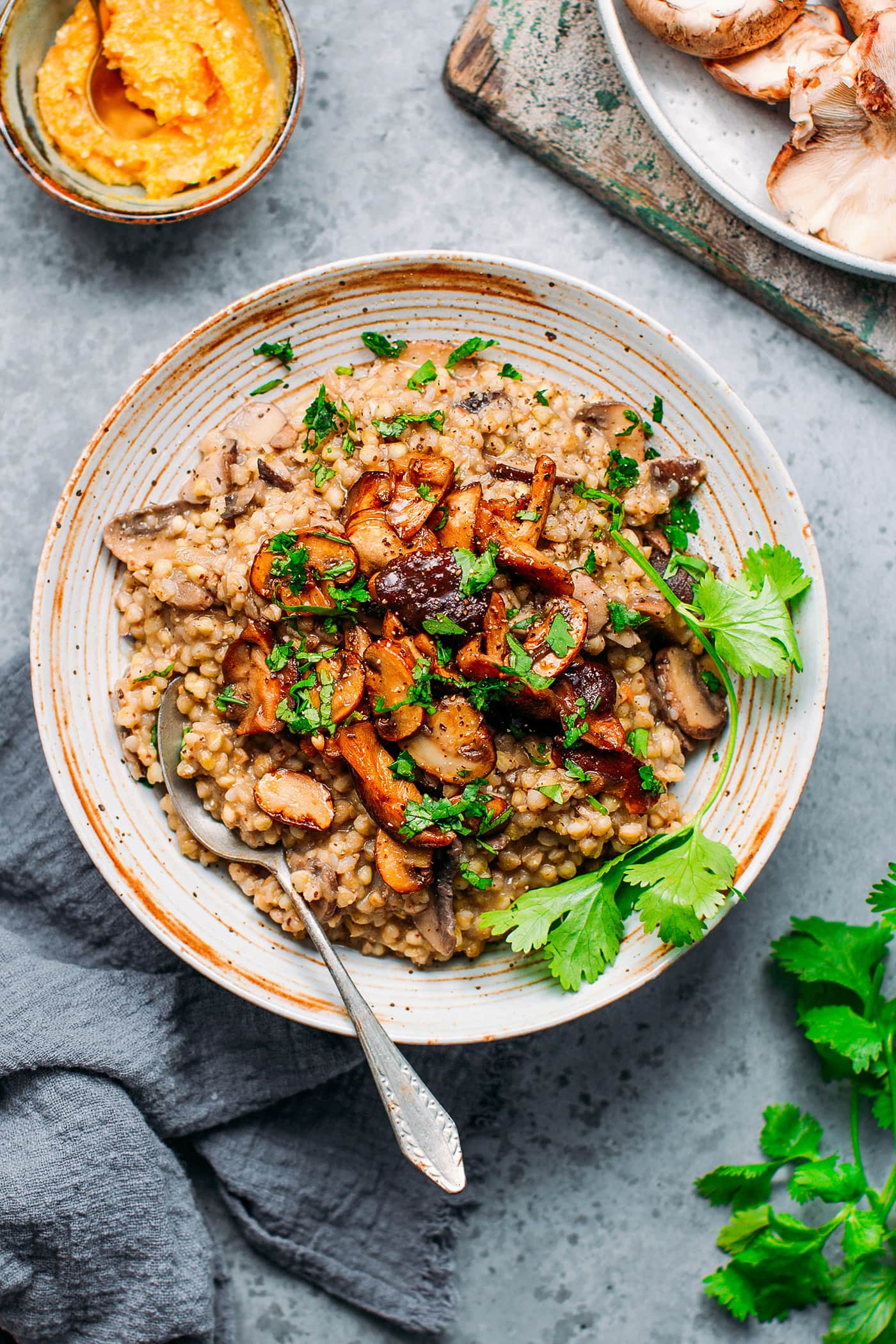
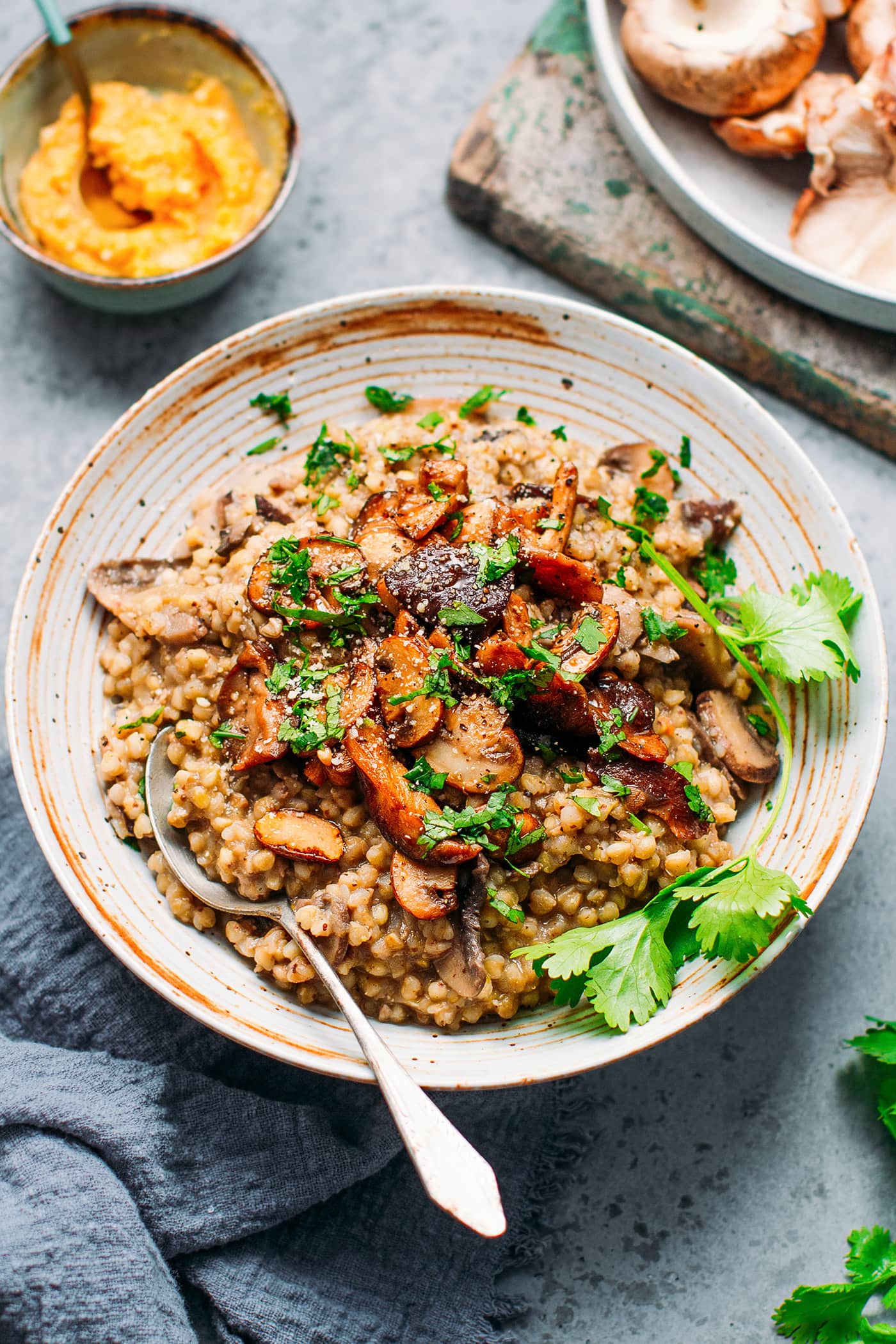

Save this recipe!
Enter your email below and I’ll send it to your inbox!
Plus, you will receive new recipes every week!
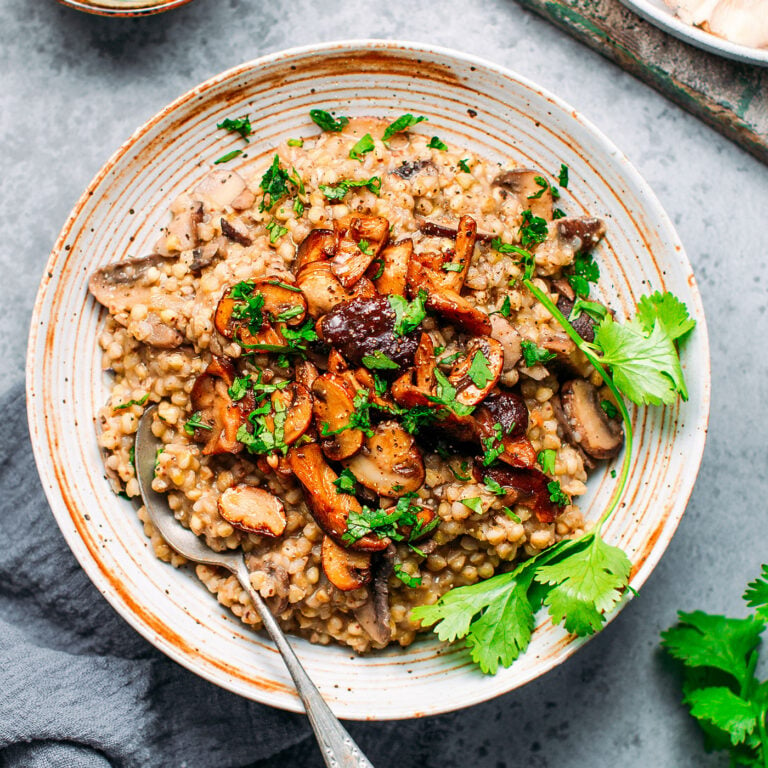
Miso Mushroom Buckwheat Risotto
Ingredients
- 1 tbsp (20 g) vegan butter
- 2 shallots minced
- 2 cloves of garlic minced
- 2 cups (120 g) sliced mushrooms of your choice
- 1 cup (150 g) raw buckwheat groats
- 1/2 cup (120 ml) white wine
- 2 and 1/2 cup (600 ml) low-sodium vegetable broth
- 2 tbsp (20 g) nutritional yeast
- 1/2 tsp ground black pepper
- 1 tbsp (20 g) vegan butter
- 1 tbsp (17 g) white miso
- parsley or cilantro for topping
Sautéed Mushrooms (optional)
- 1 tbsp (15 ml) oil
- 1 cup (60 g) sliced mushrooms
- 1/2 tbsp (7 ml) soy sauce
- 1/8 tsp ground black pepper
Instructions
- Sauté the aromatics. Heat the butter in a deep, non-stick skillet over medium heat. Once hot, add the minced shallot and garlic, and sauté for 2-3 minutes.
- Cook the mushrooms. Add the sliced mushrooms and sauté for 3 more minutes. Turn up the heat to high and sauté for one more minute or until the mushrooms are seared and slightly golden brown on the edges. Next, add the buckwheat groats and sauté for another 2 minutes.
- Pour in the wine. Deglaze the skillet with the white wine and let simmer for 2-3 minutes to allow the alcohol to evaporate.
- Let simmer. Pour in the vegetable broth and simmer over low-medium heat, uncovered for about 35 minutes, or until the buckwheat groats are tender. Keep an eye on it and stir regularly. Add more water/vegetable broth if needed, you want the buckwheat groats to have a creamy consistency.
- Season. Once the buckwheat is tender, stir in the nutritional yeast, white miso, vegan butter, and ground black pepper, and cook for one more minute. Taste and adjust the saltiness if needed.
- Serve! Finally, garnish with chopped fresh parsley or cilantro and sautéed mushrooms (optional)!
- You can store the risotto in the refrigerator for up to 3 days.
Sautéed Mushrooms
- While the risotto is cooking, heat a tablespoon of oil in another non-stick skillet over medium heat. Add the sliced mushrooms and cook for 3-5 minutes or until they are slightly golden brown.
- Pour in the soy sauce, season with ground black pepper, and toss to coat. Cook for one more minute and set aside.
Notes
Use a low-sodium vegetable broth.
As I wrote in the ingredient notes, the miso, which is added toward the end of cooking, adds a lot of saltiness, so it’s essential that you use a low-sodium vegetable broth. Otherwise, your risotto will be too salty. No low-sodium vegetable broth: Dilute regular broth with 1/3 of water.Sear the mushrooms.
For extra earthiness, turn the heat up while cooking the mushrooms and sauté them until they are almost charred on the edges. This extra step will slightly caramelize them and add even more flavor!Monitor the level of liquid.
I suggest staying close to the pan while cooking the groats and adding more vegetable broth if needed. This will prevent the groats from sticking to the bottom and burning.Nutrition

About the Author
Thomas Pagot is the founder, photographer, and recipe developer behind Full of Plants. He created the blog in 2016 as a personal cookbook for vegan recipes. Through years of recipe development, Thomas has successfully grown Full of Plants into a trusted resource for plant-based recipes.




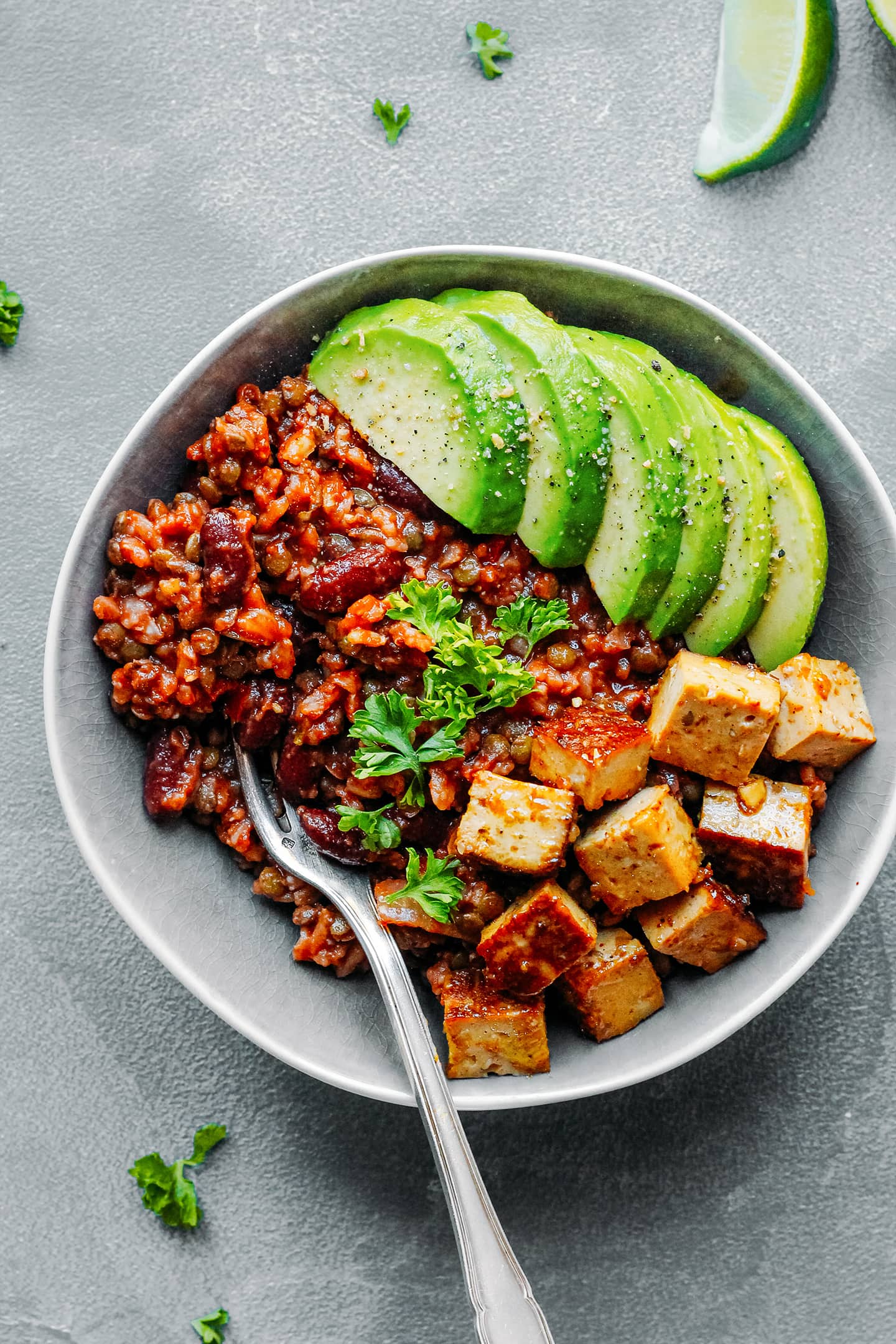
Leave a Comment
This has become a new favorite for me 👍! I’m new to cooking with buckwheat, and your instructions made it so easy. Loved it! I’ll be making this often.
Thanks so much for your feedback Elisa!
lovely recipe, nice and easy and very tasty!
Thanks for your feedback Sally!
This was so good! I was a bit sceptic about a buckwheat risotto at first but it was amazing, another winner from you! Made the extra shiitake mushrooms, and I added some broccolini, peas and spinach for extra veggies and it was really tasty altogether. Thanks!
Thanks for your feedback Audrey! 🙂
This was good. Made in. Instant port – 1c groats with 1.5c water. Didn’t bother with extra mushrooms, but did use a splash of soy sauce. Thanks Thomas.
Thanks for your feedback and rating Sue!
What would happen if I use roasted buckwheat groats, not raw?
The flavor of the risotto will be a bit nuttier.
The risotto turned out amazing! I am not a big rice eater but I could eat your risotto all the time. Everyone loved it! Thank you for sharing the recipe.
Thank you so much for your feedback Daniela 🙂
Just made and ate your buckwheat risotto. It was delicious! (Like all your recipes). Why not use wine is unclear to me. The alcohol evaporates and only the lovely taste remains. If you use vegan wine there is nothing to complain about. After all, vegan wine is not clarified with animal products.
Thanks so much Kathleen! Glad you liked it 🙂
I agree, white wine is totally fine and there is no alcohol in the final dish.
Yes Thomas, but perhaps you’ll need to mention that they’ll buy vegan wine. A lot of people don’t know that this wine exist. It’s important for people who are strict vegans, because they cannot use normal wine.
that looks yummy. Is there a substitute for the wine? thanks.
There is no good substitute I’m afraid, you could try adding a teaspoon of lime juice, but the flavor won’t be the same.